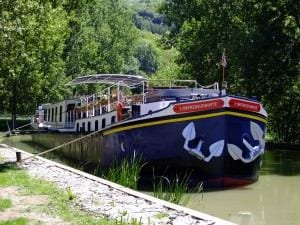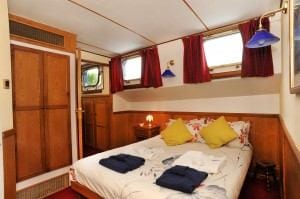Travel News
Discover a New Way to Cruise…on a Barge
Going against the trend of cruising on mega-ships, barge cruising is an intimate affair. Seasoned traveler Irvina Lew explains what it’s all about in her latest report.
Barge cruising is a casual, culturally rich immersion into an aesthetically pleasing area. One of the aspects that makes it different from mainstream cruising is that the destination is always in view and reachable down the gangplank, along the towpath, or in a nearby chateau, market, winery or village. I’ve traveled three times on the European Waterways fleet, which plies placid and pristine canals through rural England, Italy, Ireland, Scotland, The Netherlands and France, where this Francophile loves to visit.
Wherever the destination, it’s the numbers that set barges apart. While typical cruise ships accommodate 300-3000 and riverboats transport 75-150, the guest count on a barge can be in the single digits to teens. And, there are about two guests for each staff member. Typically, the captain, the chef and tour guide are experienced pros; deckhands, housekeepers and hosts are young, multilingual multitaskers and most speak English as their native language.
Single digits also describe the speed of canal barge travel; they glide at a snail-like, four mile per hour pace and travel about 25 miles on a six-night voyage. Guests who bike, even walk along the towpath, usually reach the next lock or dock before the barge.
Speed aside, barges can be thrilling. In France, the 100-canal waterway system dates from that the 17th century and extends almost 5000-miles. There are more than 200 locks in the Burgundy Canal—part of the link from the Atlantic Ocean to the Mediterranean Sea—that lift and lower barges from between 200 feet to almost 1000 feet above sea level. It’s a thrill to witness a captain who navigates 40 locks a week in a space only inches wider than the barge’s 16 foot, six inch beam. Lockkeepers are impressive too, as are their canalside cottages, gardens and, always, their dogs. (Many still take their traditionally lunch break between noon and 2 pm.)
 Itineraries matter on every voyage. On L’Impressionniste, the 12-passenger barge on which I traveled this April, James, the former captain and Burgundian tour guide guru, plans the voyage so guests never see another barge, nor a suburban housing complex, only an ever-changing, picturesque, painter-worthy landscape.
Itineraries matter on every voyage. On L’Impressionniste, the 12-passenger barge on which I traveled this April, James, the former captain and Burgundian tour guide guru, plans the voyage so guests never see another barge, nor a suburban housing complex, only an ever-changing, picturesque, painter-worthy landscape.
Passengers on barge cruises usually consider gastronomy a major lure; in part, because the ingredients are market fresh and the chefs are talented and serve only 12 passengers a meal plus the crew. Meals can be individualized. Buffet breakfasts feature croissants from the boulangerie, fruits, hams and cheeses from the markets. At mid-day and evening three-course meals, regional foods prevail. The chef featured wonderful Burgundian specialties: cheesy gougères or soupe a l’oignon to garlicky escargots, boeuf bourgignon, Poulet de Bresse and beautiful lamb chops. At each meal, the server presents one red variety and one white and a selection of three cheeses: Chaource or Chambertin; Soumaintrain or an aged St. George; a rich Brillat Savarin or Epoisse washed in Marc de Bourgogne. Perhaps, a Tomme de Savoie, a strong Alpine bleu cheese. On many barges, an on shore meal at a Michelin-starred or top local restaurant is included. (For passengers on L’Impressioniste, it’s within walking distance at L’Abbeye de la Bussiere, an historically significant Relais & Chateaux.)
On mainstream cruises, bar bills can be astronomical. On these barges, all wines, beer, drinks served on board (and on shore wine tasting excursions) are included. Regional vintners provide L’Impressionniste with amazing oenophile-known labels: Marsanny, Morey-Saint-Denis, Chassagne Montrachet, Chagny, Savigny-les-Beaune.
 L’Impressionniste is a 1960s Dutch cargo barge that was converted to a hotel barge in 1998 and outfitted with a “saloon” with a lounge, bar and dining room and an aft deck for dining, lounging and soaking (in a Jacuzzi). Refurbished in 2009/2010, the accommodations are cozy and comfortable; with closet, private bath and storage; some suites have opening portholes. It’s a small, easy to manage vessel for anyone able to walk up/down the staircase that connects staterooms from the main deck.
L’Impressionniste is a 1960s Dutch cargo barge that was converted to a hotel barge in 1998 and outfitted with a “saloon” with a lounge, bar and dining room and an aft deck for dining, lounging and soaking (in a Jacuzzi). Refurbished in 2009/2010, the accommodations are cozy and comfortable; with closet, private bath and storage; some suites have opening portholes. It’s a small, easy to manage vessel for anyone able to walk up/down the staircase that connects staterooms from the main deck.
Knowledgeable tour guides take guests on daily shore excursions, which can be adapted, especially with only five or six guests in a van. Folks who stay on board while the boat is cruising (or while others tour), read, doze, take pictures, soak in a Jacuzzi; others walk the towpath, cycle for miles in the countryside or go ballooning. Themed trips attract golfers, wine aficionados and group charters; charters lure families and friends to travel together.
Having traveled on three barges in Burgundy (what can I say, I love white Burgundy wine), I am convinced that it is the simplest way to vacation wonderfully well.
Need-To-Know Barge Travel Tips
- Keep it simple: Stay at the hotel from which the driver transports passengers to the gangplank.
- Pack light: Bring a rain jacket, casual layers, plus a change for dinners, a restaurant and the Captain’s Dinner.
- Bring: adaptors for the country’s electrical outlets.
- Use: In room safe and hair dryer.
- Don’t expect: TVs or WiFi. Internet service is variable.
- Tip fairly: A 5 percent-7 percent tip is recommended, deserved, if not required.
For l’Impressioniste: A 6-night cruise starts at $4,750 per person for a twin/double en suite cabin; meals, wines, open bar, excursions and local transfers are included. European Waterways, 877-879-8808.
For the latest in cruise travel, check out:
- Know Your Cruise Passenger Rights
- 4 Things Wrong with Cruising in 2013 & How You Can Benefit
- What Happens When a Cruise Ship Catches Fire
- How to Save a Cruise Line: A CEO Speaks Out
By Irvina Lew for PeterGreenberg.com. Irvina Lew is a writer who specializes in travel and spas. She is also the author of Romantic Weekends In and Around New York. Visit her online at IrvinaLew.com.












